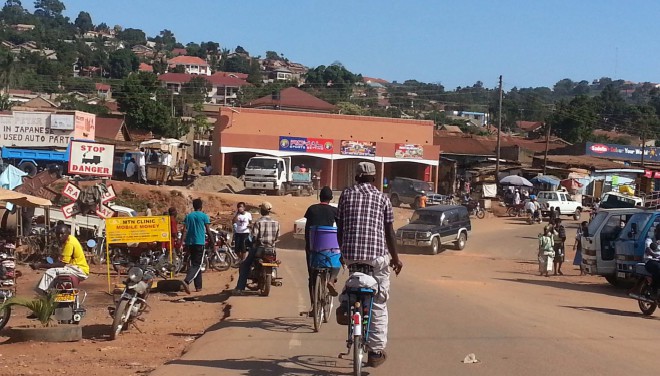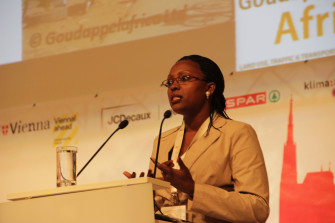
Amanda Ngabirano – “Kampala’s cyclists are my heroes”
Amanda Ngabirano – “Kampala’s cyclists are my heroes”
When Amanda Ngabirano, one of the stars of Velo-city 2013, gets on her bike, it’s either quite hot or during a thunderstorm. Kampala, the capital of Uganda, is the place with the most thunder and lightning in the world. Yet this does not keep its citizens from enjoying cycling as much as anyone else.
And to believe Amanda, more and more Ugandans have recently discovered the advantages of cycling, something she promotes with growing success in her capacity as a university lecturer and consultant for Goudappel Africa.
Goudappel Africa, bearing its name in reference to its Dutch-style cycling friendliness, is a consultancy firm founded by Amanda out of passion for integrated transport planning – something Ugandan cities urgently need. As many other developing countries, Uganda has experienced a boom in private car ownership in recent years. The motorization craze has led to serious problems with congestion, air quality and traffic safety. We have asked Amanda how she tries to convince Ugandans that cycling could be the solution.
Amanda, what’s the story behind your commitment to cycling?
Having been born and raised in Uganda, where the cycling culture is very weak, I was faced with a cultural shock when I arrived in the Netherlands, where I studied for my master’s. There were so many cyclists of all ages, different social status and both sexes! All the time I was in the Netherlands, I was in perfect health, and saved a lot of money because I was always using my bike.
At the same time, I thought about those who ride in Uganda, especially in the city of Kampala. They were my heroes, and I thought they deserved to be rewarded and treated better.
How many people are cycling in Kampala? Who are they?
We don’t know exactly how many people are cycling and for what purposes. But there are definitely a considerable number of cyclists. It is also visibly increasing. Those who ride today seem to be the youth, students, private security guards, and retail business owners. I highly doubt that those who use the bicycle as a means of transport are rich or middle income class people, though.
Before motorization started to catch on, people would move in different ways, and the bicycle also had its place. I remember that one thing a home had to have while I was growing up was a good bicycle for the boys and the ‘man’ in the house to do errands. There also were places to have bikes fixed in the neighbourhoods. Until now, there are rural homes where the bicycle has this important status.
How did you realize cycling could be a solution to improve mobility in Kampala?
I had never heard of any cycling promotion activities in Uganda. So I wrote my master’s thesis on bicycle transport and transport planning for Kampala City. To my first meeting with an official at Kampala City Council, I went with a copy of my thesis, and gave it to him as a gift.
At first the city authority was against the whole idea. They used to say, ‘Amanda, we are kicking bodabodas out of the city and you are suggesting that we bring in bicycles’. Bodabodas are the commercial motor cycles in Kampala and a “curse” to all other road users because their riders are so reckless. The city authorities first linked my idea to that, but I managed to defend my choice and did not accept that cyclists were being compared to motor cyclists.
In the end the official I talked to made good use of my thesis, and ultimately became a passionate cycling supporter. Since the local authorities were on board, my passion and commitment got even stronger.
How can you make cycling better in Kampala?
The current cyclists should be encouraged to continue riding and the authorities should plan for their safety first and foremost. At this moment cyclists are still completely at the mercy of the motorists. Because I occasionally drive, I never miss seeing cyclists when I am driving and always give them way, even when I have the right of way. Sometimes, this is annoying to the motorists behind me, but this kind of treatment is rewarding to a cyclist and creates a feeling of safety.
Is the attitude of Kampala’s city planners and politicians changing?
The attitude is changing but not as fast as it should. Cycling policy is rather implemented by city planners without politicians playing a bigger role. We still need that person in politics who will spearhead the cause for cycling. But mid this year, a national non-motorized transport policy was launched, and this hopefully provides a good basis for future cycling proposals.
What are your plans for the future?
Our plans are mainly related to promoting cycling because of its benefits, and not because it is good for us since we are poor. Offering bicycles to people because of their poverty situation is a terrible thing for cycling.
The image of the bicycle has to be positive. If you are giving me a bicycle, please tell me that I need it because it will keep me healthy and help me get where I want quickly and affordably. Do not tell me that you are giving it to me because I am poor. Otherwise, I may reject it out of pride. And the rich may never consider it at all. So together with my partner organizations, we intend to systematically improve the image of cycling.
Interview: Karsten Marhold
About the Author
 Karsten Marhold works as Communications Assistant at the European Cyclists’ Federation. He has a masters degree in European history and cultures and is a researcher in European Integration in Brussels. His interests focus on cycling as a sustainable form of mobility and the corresponding EU policies.
Karsten Marhold works as Communications Assistant at the European Cyclists’ Federation. He has a masters degree in European history and cultures and is a researcher in European Integration in Brussels. His interests focus on cycling as a sustainable form of mobility and the corresponding EU policies.
- Log in to post comments
Contact the author
Recent news!
Upcoming events
Contact Us
Avenue des Arts, 7-8
Postal address: Rue de la Charité, 22
1210 Brussels, Belgium











